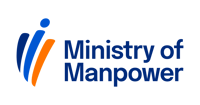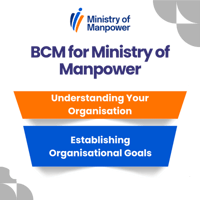Chapter 3
![BCM [E1] [C3] Establishing Organisational Goals Banner](https://blog.bcm-institute.org/hs-fs/hubfs/BCM%20E1%20Blog%20Banner/BCM%20%5BE1%5D%20%5BC3%5D%20Establishing%20Organisational%20Goals%20Banner.png?width=750&height=150&name=BCM%20%5BE1%5D%20%5BC3%5D%20Establishing%20Organisational%20Goals%20Banner.png)
Identifying Organisational Goals for BCM for the MOM Singapore
Introduction
For the Ministry of Manpower (MOM), a public-sector agency tasked with shaping Singapore’s workforce policies, regulating employment practices, ensuring workplace safety, and protecting both employers and employees, clear BCM goals are essential.
These goals must be rooted in both MOM’s institutional mandate and the broader public-sector continuity expectations of the Singapore government.
In this chapter, we articulate how MOM can define its BCM organisational goals to support its mission, meet ISO 22301 requirements, and align with Singapore’s government-wide resilience policy.
Context: MOM’s Institutional Role & Stakeholders
To set meaningful BCM goals, MOM must first acknowledge its operating context:
- Mandate and Functions: MOM regulates employment standards, supports workforce development, enforces workplace safety, and provides social protections. Its decisions directly impact employers, employees, unions, and other tripartite partners.
- Critical Services: Some of MOM’s functions are time-sensitive (e.g., workplace
inspections, labour dispute resolution, crisis communications in employment matters) — disruption to these could have significant social and economic consequences. - Public-Sector Risk Landscape: As a government ministry, MOM is exposed to a range of risks, including natural disasters, pandemics (e.g., COVID-19), cyber incidents, supply-chain or IT dependencies, reputational risks, and systemic shocks.
- Policy Framework & Government Resilience Expectations: MOM must align with national continuity frameworks like SGSecure, whole-of-government business continuity planning, and resilience standards across public agencies.
Guiding Principles from ISO 22301 & Singapore Standards
When setting BCM goals, MOM should base them on well-recognised frameworks:
- ISO 22301 (Business Continuity Management System): This standard requires organisations to establish, implement, maintain, and continuously improve a BCMS, aligned with their context, interested parties, and risk exposure.
- Singapore Standards & Adoption: Singapore has adopted ISO 22313:2020 as a local standard that guides BCMS implementation.
- Legacy BCM Standard: Earlier, Singapore had SS540 (BCM standard) before the adoption of ISO 22301.
- Continuous Improvement Mindset: Consistent with BCM best practices, MOM’s continuity system should not be static. It should embed mechanisms for regular threat monitoring, review, testing, and enhancement.
Key Organisational Goals for MOM’s BCM Program
Drawing on MOM’s public-sector mission and BCM frameworks, the following are suggested high-level goals. These should be cascaded into tactical objectives and actions.
Ensure Uninterrupted Delivery of Critical Services
- Protect MOM’s core regulatory and inspection operations so that essential employment-protection functions (e.g., workplace safety inspections, licensing, labour mediation) continue with minimal disruption.
- Maintain timely communication and service to tripartite partners, employers, and workers, especially during crises.
Translating Goals into ISO 22301-Compliant Objectives
To satisfy ISO 22301 requirements, MOM should convert its organisational goals into measurable BCM objectives.
For Example
|
Organisational Goal |
Sample BCM Objective |
Key Performance Indicators (KPIs) |
|
Ensure uninterrupted delivery of critical services |
Recovery time objective (RTO) for core regulatory functions |
Percentage of essential processes recovered within the defined RTO after a test or disruption |
|
Embed BCM in routine operations |
Risk assessments and BIAs are updated annually |
Number of risk assessments / BIA updates; proportion of business units with updated continuity plans |
|
Strengthen resilience in the workforce. |
Capability to operate remotely for 80% of staff during prolonged disruption |
Proportion of staff with remote work capability, time to deploy remote working, and recovery point objectives (RPO) for IT |
|
Public trust and communication |
Crisis communication plan tested annually |
Time to issue public communications in exercises; stakeholder feedback on clarity and timeliness |
|
Compliance with national frameworks |
Internal BCM audit schedule and management review |
Number of internal BCM audits per year, number of management reviews, and improvement actions closed |
|
BCM culture & awareness |
Staff training and exercise participation |
Percentage of staff trained in BCM; number of tabletop/activation exercises per year |
Challenges and Considerations for MOM
When setting and pursuing these goals, MOM should be mindful of several unique challenges:
- Complex Stakeholder Landscape: MOM’s stakeholders include not just internal divisions, but also external groups (employers, unions, workers). BCM objectives must reflect and balance these interests.
- Regulatory Risk vs Operational Risk: Some disruptions may jeopardise compliance or regulatory enforcement, which have reputational and policy implications. BCM planning must include both operational continuity and regulatory resilience.
- Resource Allocation: BCM requires sustained investment in people, infrastructure, training, and exercising. MOM must justify resource allocation in its budget cycles by demonstrating how BCM contributes to mission assurance and risk mitigation.
- Inter-Agency Coordination: Some continuity scenarios (e.g., national emergencies) will involve multiple ministries. MOM’s BCM goals must dovetail with broader government continuity strategies.
- Evolving Threat Landscape: The risk environment (cyber threats, pandemics, supply-chain shocks) is dynamic. Goals and continuity plans must be regularly reviewed and updated to address emerging risks.
Governance and Accountability
To operationalise the BCM goals, MOM should establish a robust governance structure:
- Steering Committee: A BCM Steering Committee chaired by senior leadership (e.g., Permanent Secretary) to provide strategic direction, approve BCM policies, and allocate resources.
- BCM Office / Secretariat: A dedicated BCM team accountable for managing risk assessments, BIAs, plan development, exercising, audits, and continuous improvement.
- Business Continuity Champions: Appoint continuity champions or focal points across departments (e.g., inspections, HR, IT) to embed BCM in their functional areas.
- Management Review & Reporting: Establish regular management reviews (quarterly or semi-annually) to assess BCM performance, review KPIs, and endorse improvement actions.
- Audit & Assurance: Perform independent audits (internal or external) on BCM, in alignment with ISO 22301, to validate readiness and compliance.
Balancing Ambition and Achievability
While MOM should aim for a mature, ISO-aligned BCMS, it is essential to phase its goals pragmatically:
- Phase 1: Build foundational BCM capability — risk assessment, BIA, continuity plans for critical functions, basic exercising.
- Phase 2: Formalise BCM governance, conduct cross-functional exercises, improve remote working recovery, and refine communication protocols.
- Phase 3: Institutionalise continuous improvement, integrate BCM into performance management, conduct external audits for ISO certification (if aligned), and embed BCM in organisational culture.
Setting clear, well-aligned BCM goals is a vital step in building a resilient Ministry of Manpower.
These goals not only help MOM meet its statutory and operational responsibilities during disruptions but also support its strategic mission: fostering a safe, fair, and productive workforce ecosystem in Singapore.
By aligning continuity efforts with ISO 22301 principles and Singapore’s public-sector resilience frameworks, MOM can strengthen its capacity to anticipate, respond to, and recover from crises—and in doing so, sustain public trust and fulfil its critical role in the nation's social and economic fabric.
More Information About Business Continuity Management Courses

 To learn more about the course and schedule, click the buttons below for the BCM-300 Business Continuity Management Implementer [B-3] course and the BCM-5000 Business Continuity Management Expert Implementer [B-5].
To learn more about the course and schedule, click the buttons below for the BCM-300 Business Continuity Management Implementer [B-3] course and the BCM-5000 Business Continuity Management Expert Implementer [B-5].
![Register [BL-B-3]*](https://no-cache.hubspot.com/cta/default/3893111/ac6cf073-4cdd-4541-91ed-889f731d5076.png) |
 |
 |
 |
 |
 |
![FAQ [BL-B-3]](https://no-cache.hubspot.com/cta/default/3893111/b3824ba1-7aa1-4eb6-bef8-94f57121c5ae.png) |
If you have any questions, click to contact us.
|
 |
 |
 |
 |





![Banner [Summary] [BCM] [E1] [C3] Establishing Organisational Goals](https://no-cache.hubspot.com/cta/default/3893111/7eb27b7d-1983-46c4-9f1b-83d2ceaccd0d.png)
![[BCM] [MOM] [E1] [C1] Overview of BCM Case Study](https://no-cache.hubspot.com/cta/default/3893111/63f94d49-e7be-4ade-93b0-cb4d5c505d69.png)







![[BCM] [MOM] [E1] [C10] Identifying Critical Business Functions](https://no-cache.hubspot.com/cta/default/3893111/f19dbb07-448c-4021-9605-82ad98643d7f.png)


![Email to Sales Team [BCM Institute]](https://no-cache.hubspot.com/cta/default/3893111/3c53daeb-2836-4843-b0e0-645baee2ab9e.png)

